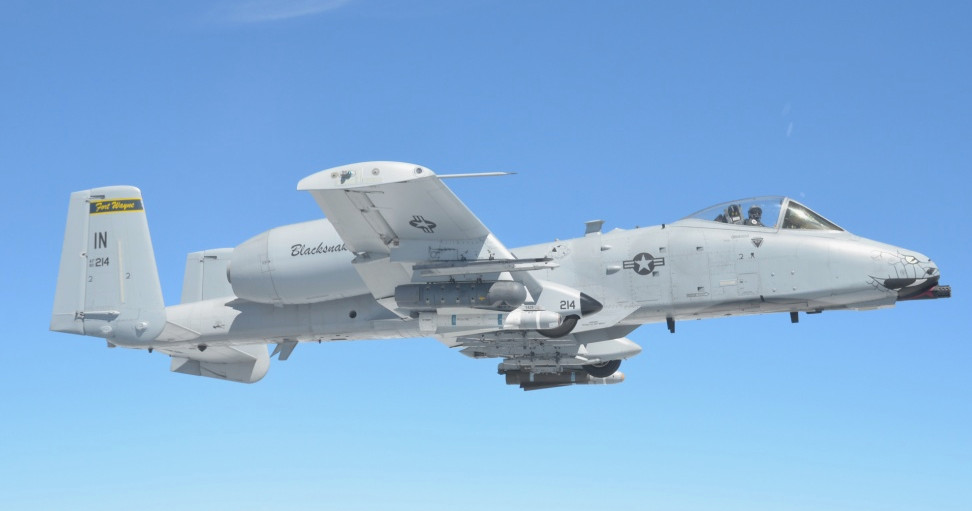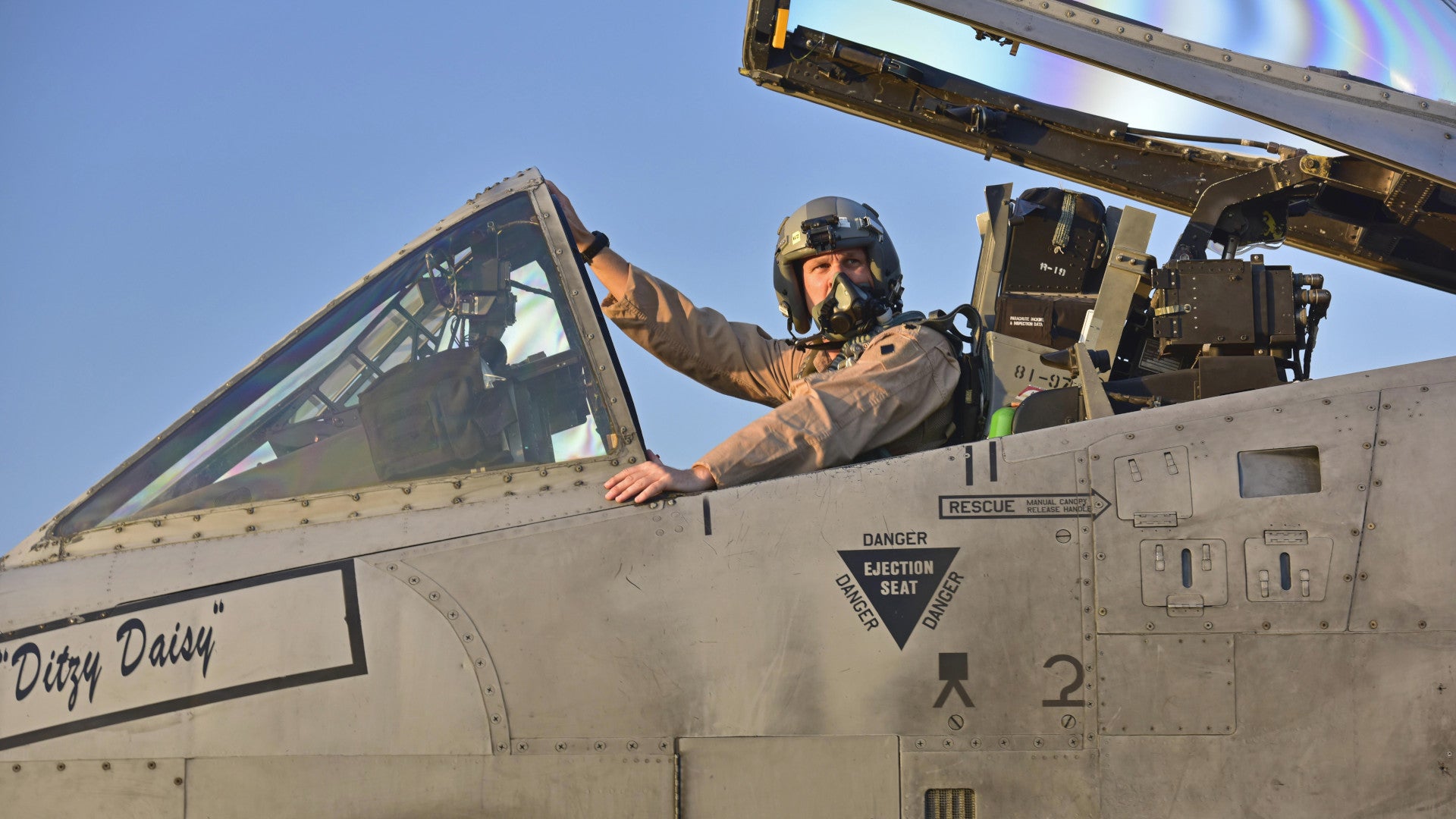The future of the U.S. Air Force’s A-10 Warthog ground attack aircraft is as uncertain as ever, but the service continues to upgrade portions of the fleet. Now, between 150 and 200 A-10s look set to receive a major cockpit audio update that will help manage radio communications and, similar to surround sound in a movie theater, issue directional auditory warnings that immediately draw the pilot’s attention in a specific direction toward a threat or other area of interest.
On Nov. 5, 2018, Air Force Materiel Command announced plans to award a sole-source contract to Danish defense contractor Terma for the purchase of that company’s Aircraft Audio Management System (AAMS). The Air Force had first indicated that it was looking for a three-dimensional audio update for a portion of its A-10s in December 2017.
The stated goal of the Warthog upgrade program is to “to drastically improve the spatial, battlespace, and situational awareness of the A-10C pilots,” according to the original contracting notice. Terma says its system provides those capabilities, as well as helping trim pilot workload, reduce hearing loss and operational fatigue, and improving intelligibility of audio signals and communications to the pilot.
Terma’s AAMS couples a stereo headset with a digital audio control system that links into various aircraft systems. It’s become quite popular over the years and is in service with the Danish Air Force on its F-16 Viper fighter jets and with the Royal Air Force, paired with BAE’s Striker II helmet-mounted display, for pilots flying the Eurofighter Typhoon. Other F-16 operators, including the U.S. Air Force, are set to integrate the three-dimensional audio system into their Vipers, as well.

It’s most basic functionality gives pilots the choice to program individual audio sources to sound like they’re coming from one specific direction or another. This means that in a plane with multiple radios, such as the A-10, the system to pipe those feeds in as if the speaker was standing in a specific position relative to the pilot, segregating the individual audio streams and distinctively separating them from other tonal alerts and noise in the cockpit in the process.
This makes it easier to identify who the speaker might be based on what radio they’re calling in on and allow the pilot to focus attention on one conversation rather than another. This is a more natural way of communicating just like you might do in real life in a room where multiple people are talking to you from different directions.
“Beforehand, years back, all these different sounds were presented to the pilot in one big blob, if you will, and it was very difficult to discriminate one signal from the other.” H.P. Bagger, a Danish Air Force F-16 pilot and the Master Chief of that service’s Fighter Branch, said in a promotional video for the audio system in 2013. “Sometimes you would miss a very important radio call because it was – maybe you were focusing your ears on a warning sign.”

That same programmable functionality also means that the AAMS can issue warnings and other alerts to the pilot in such a way that they sound like they’re coming from the appropriate direction. That position remains constant, accurate to within 15 degrees of the specific direction, even if the aviator moves their head. So, for example, instead of a tone going off in the cockpit and a control panel display showing the direction of an incoming missile, the pilot now immediately gets a sense of where the danger is coming from.
“One knows the feeling of hearing e.g. a door slam behind and instinctively and immediately knowing the position. If this was heard in a mono headset, one would not have a clue where the door was,” Terma’s website explains. “So, to provide the same level of information in a mono headset, one would need to add a statement like ‘behind you’ and such a statement takes time to speak and to understand. It should be obvious that hearing the actual door slamming is a lot faster to understand.”
For the A-10 specifically, the Air Force said it wanted the new audio system to integrate and communicate messages and other information from all of the plane’s existing radios. This includes the AN/ARS-6(V)12 Lightweight Airborne Recovery System (LARS), which the service began installing on active component Warthogs in 2017.

This radio is specifically set up to provide improved communication with downed pilots, pararescuemen, and joint terminal air controllers on the ground. It is a particularly important upgrade for the A-10 in regards to the combat search and rescue armed escort, or “Sandy” mission set, where the planes would be escorting rotorcraft to and from a crash site and providing close air support throughout that mission.
Close air support missions in any scenario are often especially tense, with the pilot trying to juggle information from personnel on the ground who may themselves be frantically trying to communicate key details while defending themselves against hostile forces. Giving Warthog pilots a way to better focus their attention could dramatically improve their ability to provide support where and when friendly forces on the ground need it the most. It may even be possible for the system to help indicate to the pilot where the fighting is going on down below, helping them get in position faster for an attack run.
The video below gives a good sense of all the radio chatter and other noise an A-10 pilot has to wade through during an actual close air support mission supporting troops under fire on the ground.

The Air Force also wants Terma’s audio equipment on the Warthogs to be able to issue three-dimensional directional alerts based on information from the pilot’s helmet-mounted sight and the aircraft’s Situational Awareness Data Link (SADL) and defensive countermeasures systems, including its radar warning receivers. Altogether, the audio upgrade will help shorten the time it takes for an A-10 pilot to react to threats, reduces their workload by allowing them to not have to constantly check various indicators on control panels in the cockpit, and simply ease the general racket of flying in a combat aircraft. In regards to that latter point, the Danish contractor says the more pin-pointed audio lowers the risk of serious hearing loss over time compared to a constant jumble of sounds layered one on top of the other.
Though this Air Force contract would be limited to adding this system to the A-10, the equipment would offer benefits for all of the service’s aircraft. Other U.S. military services would undoubtedly be interested in the benefits, as well. The improved directional audio system would be just as beneficial for rotary wing aircraft, including attack and rescue helicopters, as fixed-wing types, too.
Boeing has already proposed adding in a similar system into the cockpit of the F/A-18E/F Super Hornet for the U.S. Navy and Marine Corps, as well as foreign customers. Raytheon has also been working on their own three-dimensional audio arrangement since at least 2013.

We don’t know when the Air Force expects to begin taking delivery of the Terma audio systems or how long it will take to install them into the A-10s, but it may not be long before Warthog pilots, and other U.S. military aviators, start hearing radio calls and tonal alerts flying around them from different directions in the cockpit.
Contact the author: jtrevithickpr@gmail.com
